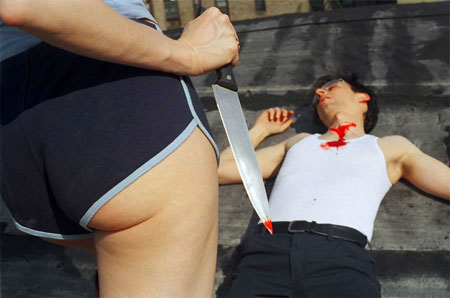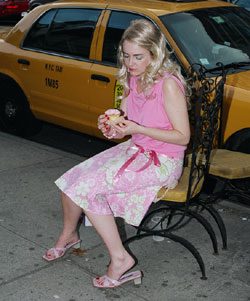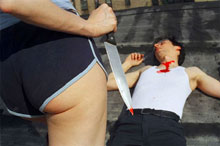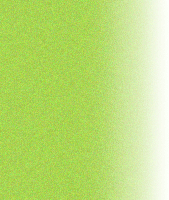
Beyond the Sherman Factor:
The Photography of Elizabeth Hendler
By Dee Dee Vega
In Laura Mulvey's seminal essay "Visual Pleasure and Narrative Cinema" she asserts that there is a pervasive gender distinction
between the archetypal roles men and women play in film. Men are the aggressors and the "agents of narrative action" and women
are relegated to passivity. In fact, much of the feminist discourse on modern cinema has centered on the relationship between
the (fictional) female in the narrative of the image and the masculine, voyeuristic gaze from the lens. Drawing upon giallo,
B-film and Hitchcock, Elizabeth Hendler presents a body of work that confronts the viewer with a startling Technicolor ferocity
and subverts Mulvey's observation about the boundaries of femininity in art and cinema. fRINGE presents three series of
Elizabeth Hendler's photography that place women in the context of a silent, photographic narrative while exploring themes of
physical experimentation, violence and perception of the body.
When you are first met with the dramatic lighting and precise composition of Elizabeth Hendler's images, it isn't difficult
to see the influence of her years of training as a painter at work. After a motorcycle accident forced Hendler to undergo
numerous surgeries and temporary confinement to a wheelchair, painting became impossible and she began her work in photography
and video. It is, on the surface, difficult to reconcile Elizabeth the person-beautiful and kind with a voice like a child
ringing a triangle in a holiday play-with the confident women unafraid to confront violence and blur the artistic lines between
what is real and what is fiction in the darker side of life.
 The Secretary Killers series situates non-actors in an ambiguous scenario that ends with a dead guy leaking some incredibly
farcical blood. The sumptuous color is offset by the fairytale Caucasian skin of the partially undressed women that suggest
sexual violence with the women as the succubus. If there is a Freudian underpinning to these photos, castration anxiety is the
name of the game. While the scenes draw upon movies-Hendler enhances this effect by using commercial Tungsten lighting-there is
no particular film that is being copied. Rather she is taping into and subverting social assumptions about women in media.
The Rooftop Killers offers a similar play on B-horror. We never think it is real, yet the sexualized body and a blood knife
is nonetheless disquieting.
The Secretary Killers series situates non-actors in an ambiguous scenario that ends with a dead guy leaking some incredibly
farcical blood. The sumptuous color is offset by the fairytale Caucasian skin of the partially undressed women that suggest
sexual violence with the women as the succubus. If there is a Freudian underpinning to these photos, castration anxiety is the
name of the game. While the scenes draw upon movies-Hendler enhances this effect by using commercial Tungsten lighting-there is
no particular film that is being copied. Rather she is taping into and subverting social assumptions about women in media.
The Rooftop Killers offers a similar play on B-horror. We never think it is real, yet the sexualized body and a blood knife
is nonetheless disquieting.
Elizabeth's most recent works recently exhibited at Brooklyn Fireproof, The Cupcake Series, places a grown up Alice in the
distorted Wonderland of New York with all the rancid beauty of the city behind her. It's impossible to discuss these works
without considering The Sherman Factor. The Sherman Factor is basically the phenomenon whereas any female photographer who
 explores female imagery in any manipulated way has to endure an unending stream of comparisons to Cindy Sherman. Cindy Sherman
is a brilliant and groundbreaking photographer, but to confine a reading of Elizabeth Hendler's work to our understanding of
art via "The Untitled Film Stills" is unforgivably limiting. The Cupcake Series presents a female "character" (not Hendler, but
an actor-Sherman's Film Stills are all images of her) in a state of physical (vomiting) and implied emotional distress. What is
making her sick? Why is she alone in the street? We are met with far more questions than answers. Perhaps feminist art scholar
Rosalind Krauss's assessment of Cindy Sherman does hold some insight as to our cupcake "doll." She writes: "Masquerade, here
understood as a psychoanalytic term, is thought of as a phenomenon to which all women are submitted both inside and outside
representation, as that as far as femininity goes, there is nothing but costume."
explores female imagery in any manipulated way has to endure an unending stream of comparisons to Cindy Sherman. Cindy Sherman
is a brilliant and groundbreaking photographer, but to confine a reading of Elizabeth Hendler's work to our understanding of
art via "The Untitled Film Stills" is unforgivably limiting. The Cupcake Series presents a female "character" (not Hendler, but
an actor-Sherman's Film Stills are all images of her) in a state of physical (vomiting) and implied emotional distress. What is
making her sick? Why is she alone in the street? We are met with far more questions than answers. Perhaps feminist art scholar
Rosalind Krauss's assessment of Cindy Sherman does hold some insight as to our cupcake "doll." She writes: "Masquerade, here
understood as a psychoanalytic term, is thought of as a phenomenon to which all women are submitted both inside and outside
representation, as that as far as femininity goes, there is nothing but costume."
www.elizart.com - To view more art by Elizabeth Hendler or contact the artist.
The Rooftop Killers

|

|
The Cupcake Series
The Secretary Killers
Previous Art Stars...
Sean Fader Photography
|




























